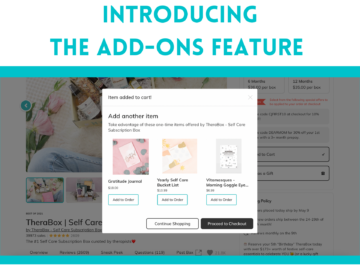Communicating with customers is one of the most fundamental parts of your business – you do it daily. Whether it’s through marketing and advertising or in customer service exchanges, the methods you use to engage with customers set the tone for your entire relationship with those customers.
For that reason, there are some best practices you might follow for positive customer connections. (And, naturally, some tactics you should avoid!)
At the heart of all customer-oriented messaging, it’s really about being clear, concise, and honest with customers, while maintaining a friendly, understanding persona. When you behave consistently like this in your messaging, you position yourself and your company to develop healthy, long-lasting customer relationships –– and that means better business.
General Suggestions for Communication
Before diving into the specifics, it’s important to understand some simple suggestions you should think of when considering how you communicate. Think of each message as a kind of rhetoric: you’re persuading the customer to remain a customer by helping them resolve a problem, marketing the unique benefits of your product offering, or otherwise meeting their needs.
In customer service, consider implementing these strategies:
Provide a clear, easy way to contact your company, whether it’s by email, phone, or another channel. For example, you might include contact information at the footer of emails, embed a support tab on your website (like Zendesk’s web widget), or print contact information on your packaging.
Create a system of checks for advertisements, showing your core team members the final draft of an ad or marketing copy before publishing. This will help prevent confusion among your team and adds another opportunity to spot errors before the ad is public.
Identify team member strengths. If one of your team members is better able to work with stressful customers, considering “tiering” (that is, transferring responsibility) to them when issues come up. If they have strong people skills or customer service experience, they’ll be better equipped to use these “do’s.”
Reflect and revise. It’s crucial to always reflect on your own strategies and specific methods of communication. How might you be clearer, more concise, or more honest with customers? Set a calendar reminder to reflect on these monthly, or as needed.
Customer Communication “Do’s”
Remember the Golden Rule from when you were a kid? Treat your customers the way you would want to be treated. While it may sound cliché, you likely already have a great sense of how to talk with customers, because you know how you want businesses to treat you. The trick here is to meet that standard efficiently while following and enforcing your rules and terms. Unfortunately, these are bound to conflict on occasion. How you deal with that conflict, though, will set the tone of your communication.
Check Your Tone
Think of your tone in writing as your company’s “voice.” While this voice can change depending on your company’s positioning, you should try to maintain a parental, kind tone, especially in customer service communications. Here, you want to embrace misunderstanding in order to remedy it.
Tip: Rather than demonstrating how a customer was wrong, try to help a customer understand better the point of their confusion.
Follow these steps to resolve the problem:
- Rephrase the question the customer has asked in your own (albeit layman’s) words, to make sure you understand their request,
- Acknowledge the problem or point of confusion in the customer’s specific case, and
- Provide a solution
Let’s look at an example.
A customer cancels a day before your shipping deadline, but you state in your Terms/FAQs that they must specifically request a refund if they intend to cancel a shipment. The customer did not request a refund, only a cancellation going forward. So they receive their last package (for the current month), are confused, and now want a refund in its place. What do you do?
- First, apologize for any misunderstanding about your policy or how canceling works. Clearly (re)state the policy in your communications. You might even link to that page of your Terms/FAQ or provide a quote from the page.
- Next, provide transcripts from their last request, which will clearly demonstrate where/how the policy was misunderstood. Explain why this policy exists.
- Finally, reaffirm your policy, but offer a new solution. Close your communications by offering the customer future help.
Here’s an example.
Hi [customer name],
We’re so sorry to hear about the confusion with canceling your subscription. As explained in our Terms and on our FAQ page, your must [RULE]. As you can see below, in your first message, we did not receive the proper request, so your last package was mailed to you.
[TRANSCRIPT COPY].
Of course, you can always read more about these terms and why we have this policy at [LINK]. In consideration of your trouble, we’d love to provide an extra [OFFER – such as 10% off that delivery or 10% off a future delivery].
Again, we do apologize for any misunderstanding. If there’s anything else I can do for you, please do not hesitate to ask.
Stay Flexible
The last example also previews another big “do” in customer communications: flexibility. Don’t consider it a weakness to be flexible for customers, even if they made a mistake or were confused about something along the way. Sometimes, offering a new solution or easing up on your own rule can win the customer back or make them reconsider their stance.
Let’s continue with our example earlier.
If the above customer was someone with a high lifetime value (LTV), it might be wiser to offer a refund and allow the customer to keep the box regardless. This generosity can impress the customer, leading them to advocate for your customer service, and even encourage them to sign up again in the future.
Strive for Clarity and Avoid Ambiguity
Always be as clear as possible in your advertising and communications to customers. Provide explicit detail, photographs when applicable, and direct links to what is being discussed (as seen in the example above).
This really comes down to setting expectations with customers. Setting clear expectations will translate to higher rates of customer loyalty.
Remember: The better your customers understand what you’re offering and your solutions, the more likely they are to have a good customer experience.
However, there is one exception where a little bit of ambiguity is not (necessarily) a bad thing.
Let’s say that in the beginning, you have only a categorical idea of what you’ll include in your box (rather than specific items). As you advertise, it’s okay to paint a picture of a product offering in broad strokes as long as you get across a clear idea of your product offering. In this case, you might present items that are similar to the ones that will actually be included.
So… Let’s Recap
The “do’s” of communications can easily be understood as:
- Maintaining a kind and empathetic tone of voice, demonstrated by active listening and clear, concise answers,
- Providing flexibility when reasonable, and
- Conveying clarity in every communication, even if the communication is purposely vague in some areas.
When you stick to these methods, excellent customer service and marketing is bound to shine through.
Customer Communication “Don’ts”
On the flip side, there are a number of things that relate to tonality, flexibility, and ambiguity that you should clearly avoid.
Being Dismissive or Negative
If a kind, parental tone is the goal, then a rude, impatient, or offensive tone is the antithesis of our goal. Avoid negative words (like “No” or “Unfortunately”) and never tell a customer “You’re wrong.” While it may feel right to do so, as customers can be mistaken on occasion, this attitude will ultimately cause more problems, rather than solve the customer’s original query.
We can’t stress enough how imperative it is to avoid a condescending or inconsiderate tone. And you don’t create tone through only the words you choose, either.
Let’s look at an example.
Before offering a solution –– such as a subscription downgrade –– check the customer’s account to see if they have already selected that option. If you don’t take a minute to do your research and listen, you risk coming off like you don’t care about the customer’s well-being. And that’s no way to retain customer loyalty.
Leaning Too Hard on Flexibility
Flexibility is important, but watch out for being too flexible with the rules. This can lead to offering confusing or complicated solutions when you communicate with customers.
Tip: Flexibility can come at the cost of simplicity, since it’s more straightforward to follow the rules. Look out for accidentally devising tricky solutions.
Sometimes, you simply need to stick with your policy. If this is the case, try to determine other solutions that are still easy (for example, a special replacement box).
Being Really Ambiguous
An overly broad set of directions or advertisement will only serve to confuse your customer or set bad expectations in their mind.
Remember: Keep in mind the “curse of knowledge.” You might think you’re being clear –– because you understand your policies best –– but because the customer doesn’t have the same familiarity that you do, you may not convey as much detail as they need to understand.
This leads to a poor customer experience and hurts their relationship with your brand. Look out for being purposely vague, especially if it’s because you’re worried about the customer’s reaction. If you must stick with your policy, do so clearly and devise a new, straightforward solution. Avoid sidestepping the issue with vague language because you’re concerned about a harsh response. Trust in your sincerity. Your customers will understand you better.
Great Communication Isn’t Hard
Communicating with customers doesn’t need to be difficult; most of these principles are common sense. As a business, you might develop your own set of Customer Service Communication Rules or Advertising Communication Rules to put these lessons into practice. Make these rules clear, concise, and keep them prominently posted around your business as reinforcement.
Remember: Your customers are your business. Without them, you have no revenue, which is your business’s heartbeat.
When you truly value and appreciate what customers do for you, communicating with them should become simple. Show them that appreciation through compassionate, responsibly flexible, and direct communications.







